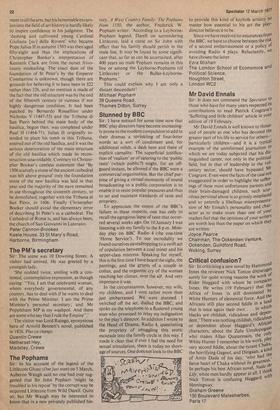St Peter's
Sir: Christopher Booker has written (5 March)with passion on what he considers to be the startlingcollapse of the modern move ment in all the arts, but his lamentable excursion into the field of art history is hardly likely to inspire confidence in his judgment. The 'dashing and cultivated young Cardinal Giuliana [sic] della Rovere' who became Pope Julius El in autumn 1503 was then aged fifty-eight and thus the implications of Christopher Booker's interpretation of Kenneth Clark are from the outset frivolously misleading. The exact date of the foundation of St Peter's by the Emperor Constantine is unknown, though there are grounds for believing it to have been in 322 rather than 326, and no mention is made of the fact that the old structure was by the end of the fifteenth century in ruinous if not highly dangerous condition. It had been patched by Bernardo Rossellino under Nicholas V (1447-55) and the Tribuna di San Piero behind the main body of the basilica, begun then, was completed under Paul 11 (1464-71). Julius II originally intended to place his tomb in this Tribuna, entered out of the old basilica, and it was the serious deterioration of the main structure of the old basilica which made its reconstruction unavoidable. Contrary to Christopher Booker's careless statement that 'By 1506 scarcely a stone of the ancient cathedral was left above ground' only the foundation stone of the new basilica was laid in that year and the majority of the nave remained in use throughout the sixteenth century, to be demolished, together with the Tribuna di San Piero, in 1606. Finally Christopher Booker should avoid the elementary error of describing St Peter's as a cathedral. The Cathedral of Rome is, and has always been, the church of San Giovanni in Laterano. Peter Cannon-Brookes Keele House, 33 St Mary's Road, Harborne, Birmingham







































 Previous page
Previous page